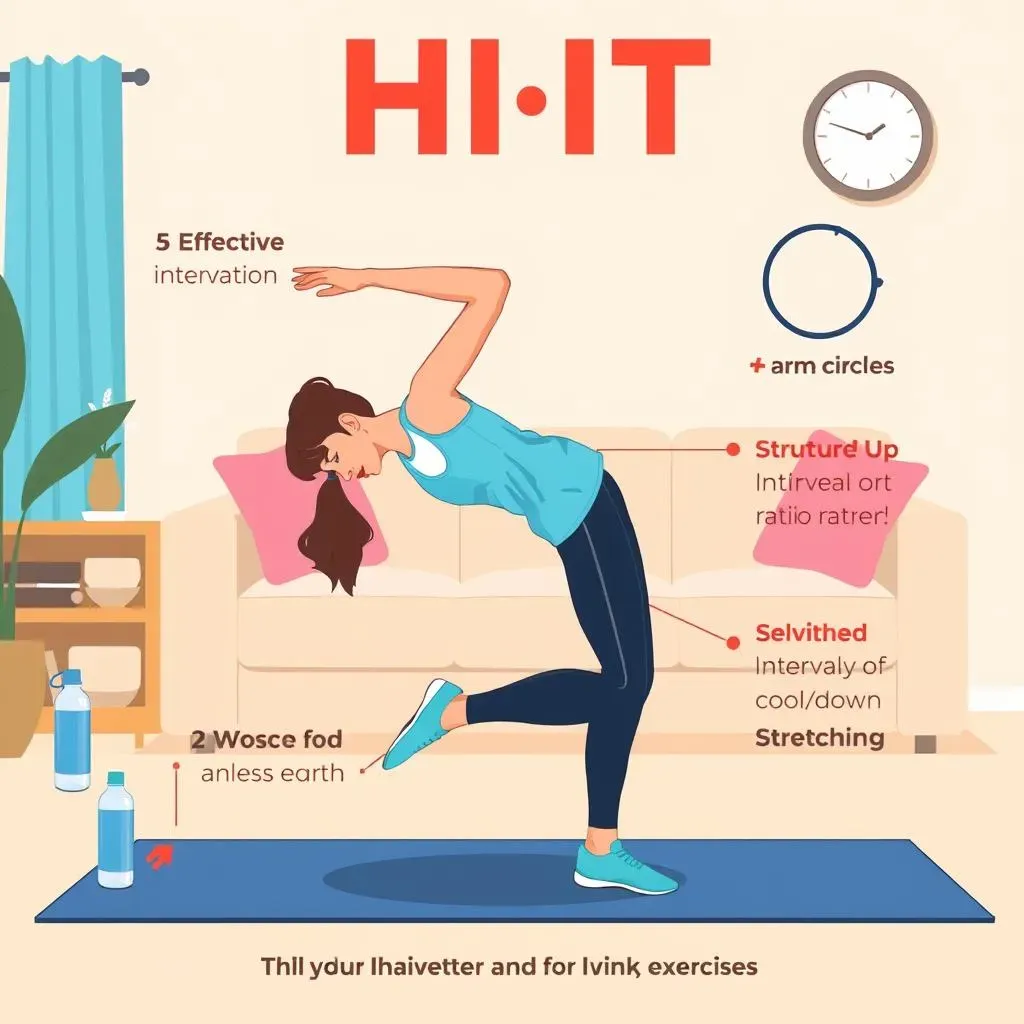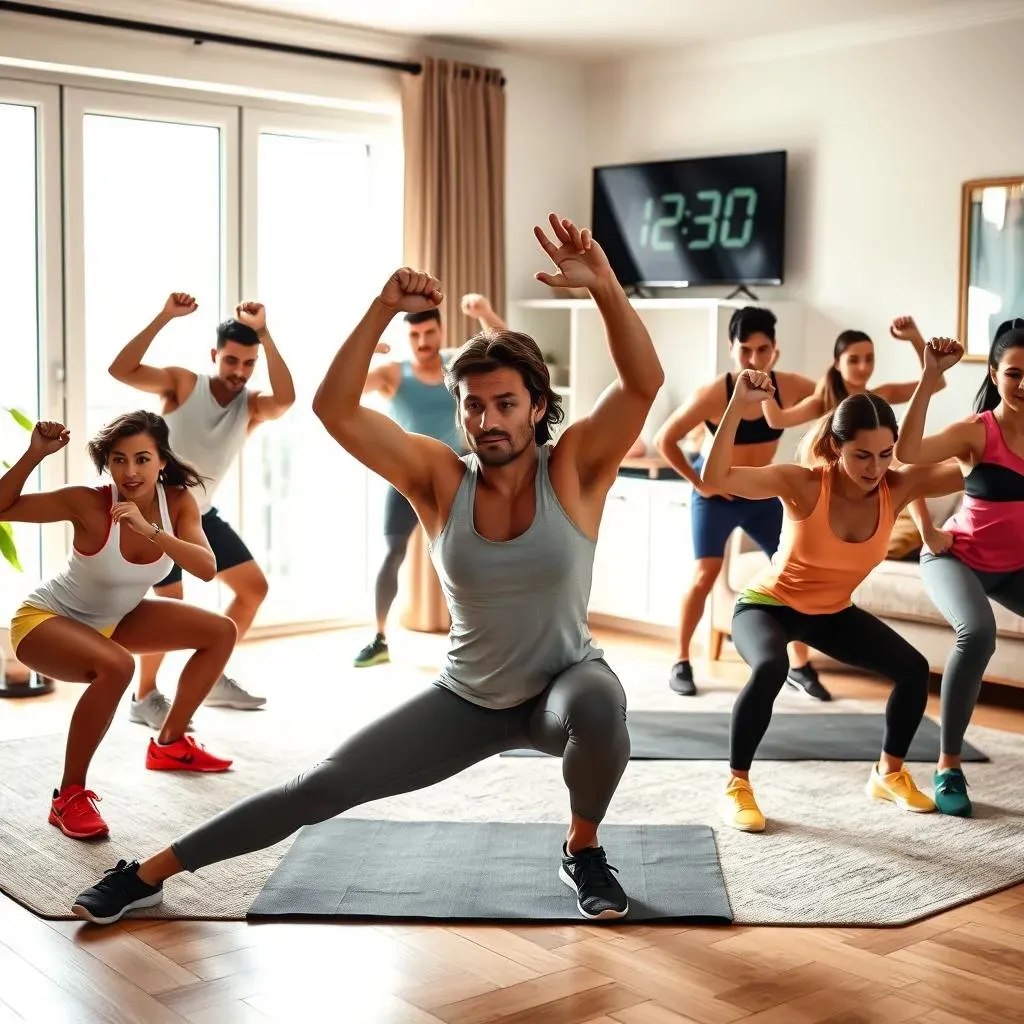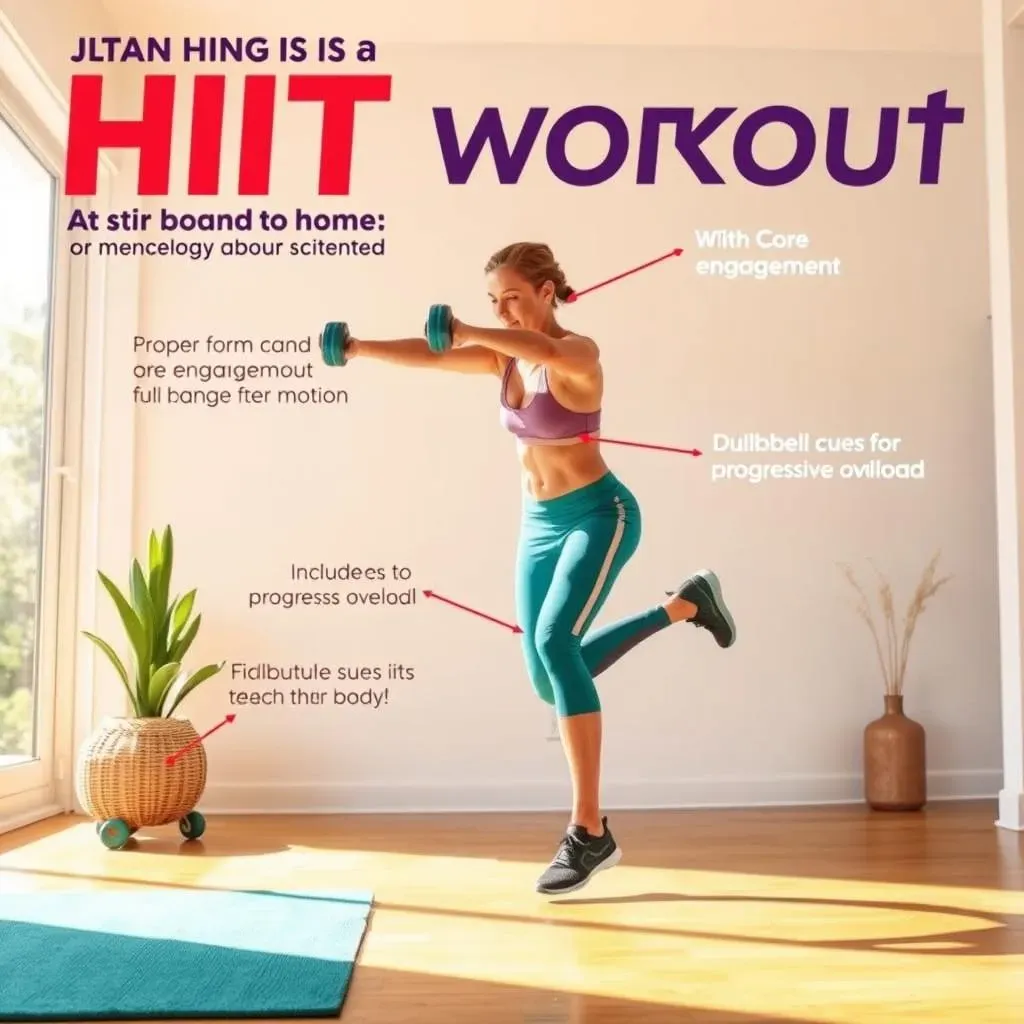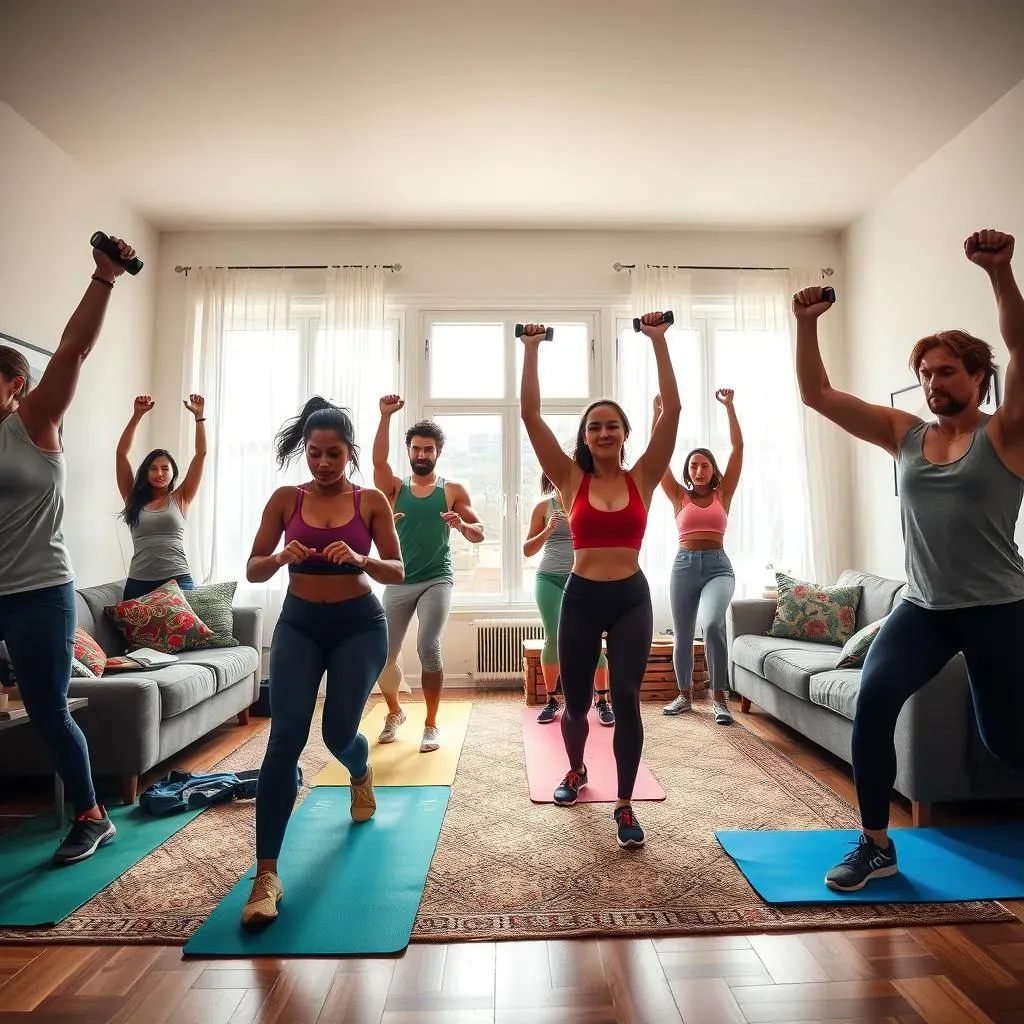Table of Contents
Stuck in a fitness rut? Wish you could torch calories and build strength without stepping foot in a gym? You're not alone. Life gets busy, and gym memberships can be pricey and time-consuming. But what if you could get a killer workout in your living room, kitchen, or even your backyard? That's where an at home HIIT workout program comes in. High-Intensity Interval Training (HIIT) is all the rage for a reason – it's efficient, effective, and adaptable to any fitness level. In this article, we'll dive into exactly what makes an at home HIIT workout program so powerful, break down the essential elements for designing your own, and give you example routines to get you sweating. Plus, we'll share pro tips to maximize your results and keep you motivated on your fitness journey. Ready to transform your body and your routine? Let's get started.
What is an At Home HIIT Workout Program and Why is It Effective?

What is an At Home HIIT Workout Program and Why is It Effective?
Breaking Down "At Home HIIT Workout Program"
so you're hearing buzz about HIIT, but maybe the term "at home HIIT workout program" still sounds a bit vague. Let's break it down. Essentially, it's a workout routine you can do anywhere, anytime, that combines short bursts of intense exercise with brief recovery periods. Think about it like this: you go all-out for, say, 30 seconds doing jumping jacks, then rest for 15 seconds. You repeat that cycle with different exercises – burpees, lunges, push-ups – all in your living room. The beauty of an at home HIIT workout program is in its simplicity and adaptability. No fancy equipment needed, just your body and a bit of space.
The Science Behind HIIT's Effectiveness
Now, why is this type of workout so effective? It's not just hype. The science backs it up. HIIT workouts are amazing because they push your body into overdrive for those short bursts. This intensity creates what's called an "afterburn effect," or EPOC (Excess Post-exercise Oxygen Consumption). Basically, your body keeps burning calories at a higher rate even after you've finished your workout. It's like getting bonus calorie burn while you're chilling on the couch! Plus, at home HIIT workout programs are fantastic for improving your cardiovascular health, boosting your metabolism, and building muscle endurance, all in less time than traditional steady-state cardio.
Benefit | HIIT Workout Program Advantage |
|---|---|
Time Efficiency | Shorter workouts, big results. |
Calorie Burn | High calorie expenditure during and after exercise (afterburn effect). |
Cardiovascular Health | Improves heart health and endurance. |
Convenience | Can be done anywhere, anytime, no gym needed for an at home HIIT workout program . |
Designing Your Own At Home HIIT Workout Program: Key Components

Designing Your Own At Home HIIT Workout Program: Key Components
Selecting Effective Exercises for Your HIIT Program
Alright, so you're ready to build your own at home HIIT workout program? Awesome! First things first, let's talk exercises. When it comes to HIIT, you want to pick movements that are going to give you the most bang for your buck. Think compound exercises – these are moves that work multiple muscle groups at once. Why? Because they ramp up your heart rate faster and burn more calories. Bodyweight exercises are your best friend here. We're talking squats, push-ups, lunges, burpees, planks, mountain climbers – you know, the classics! These don't require any equipment and can be done literally anywhere. The key is to choose exercises that you can perform with good form, even when you're pushing yourself hard.
Structuring Your HIIT Workout: Intervals and Ratios
Next up is structuring your workout. This is where the "interval" part of HIIT really comes into play. A typical HIIT workout alternates between high-intensity work periods and short rest periods. The ratio of work to rest is crucial. For beginners, a 1:1 or even 1:2 ratio works well – like 30 seconds of work followed by 30 or 60 seconds of rest. As you get fitter, you can crank up the intensity by increasing the work time or decreasing the rest time, maybe moving to a 2:1 ratio or even higher. For example, you could do 45 seconds of work and 15 seconds of rest. Experiment to find what challenges you without completely burning you out in the first few minutes. Remember, the goal of an effective at home HIIT workout program isn't just to exhaust you, but to push you to your max for short bursts and then recover just enough to go hard again.
HIIT Component | Beginner | Intermediate | Advanced |
|---|---|---|---|
Work Interval | 30 seconds | 45 seconds | 60 seconds |
Rest Interval | 30-60 seconds | 30 seconds | 15-30 seconds |
Work:Rest Ratio | 1:1 or 1:2 | 1.5:1 or 1:1 | 2:1 or higher |
The Importance of Warm-up and Cool-down
Don't even think about skipping the warm-up and cool-down! Seriously, these are non-negotiable parts of any at home HIIT workout program. A proper warm-up gets your muscles ready for action, increases blood flow, and reduces the risk of injury. Think dynamic stretches like arm circles, leg swings, torso twists, and some light cardio like jogging in place or jumping jacks. Spend about 5-10 minutes warming up. And just as important is the cool-down. This helps your body gradually recover, prevents muscle soreness, and brings your heart rate back to normal. Gentle static stretches, holding each stretch for 20-30 seconds, are perfect for cooling down. Focus on the major muscle groups you worked – quads, hamstrings, chest, back, shoulders. Trust me, your body will thank you later!
Example At Home HIIT Workout Program for Beginners to Advanced

Example At Home HIIT Workout Program for Beginners to Advanced
HIIT It Beginner Style: Getting Started Safely
so you're brand new to HIIT? No sweat! Everyone starts somewhere. For beginners diving into an at home HIIT workout program, the key is to ease in and focus on form over speed. We're not trying to break any records here, just build a solid foundation. A fantastic beginner routine could be as simple as alternating between a few basic bodyweight exercises. Think squats, modified push-ups (on your knees is totally fine!), lunges, and a plank hold. Start with a work interval of 30 seconds, followed by a rest of 60 seconds. Trust me, that rest period will feel shorter than you think at first! Do each exercise for the work interval, then rest, and cycle through all four exercises. Repeat the whole circuit 2-3 times. Remember to listen to your body. If you need to take longer breaks, do it. It's about progress, not perfection.
And hey, don't underestimate the power of walking or jogging in place during your work intervals if you need to dial it back even further. The point is to get moving and get your heart rate up, even if it's not Olympic-level intensity right away. An at home HIIT workout program is all about building up gradually. Think of it like leveling up in a game – you don't start at the boss level, right? You grind through the early stages to get stronger. Same principle applies here. Consistency is your secret weapon. Even 15-20 minutes of beginner HIIT a few times a week will make a difference.
Beginner HIIT Workout | Interval | Rounds | Rest Between Rounds |
|---|---|---|---|
Squats | 30 seconds work / 60 seconds rest | 2-3 | 2 minutes |
Modified Push-ups | 30 seconds work / 60 seconds rest | 2-3 | 2 minutes |
Lunges (alternating legs) | 30 seconds work / 60 seconds rest | 2-3 | 2 minutes |
Plank Hold | 30 seconds work / 60 seconds rest | 2-3 | 2 minutes |
Ramping It Up: Intermediate and Advanced HIIT Routines
Alright, beginner grads, let's crank up the heat! If you've been rocking those beginner workouts and feeling like you could use more of a challenge, it's time to step into intermediate and advanced at home HIIT workout program territory. For intermediate level, we're going to shorten those rest periods and bump up the intensity of the exercises. Think about switching to a 45 seconds work / 30 seconds rest ratio. And let's introduce some more dynamic movements – jump squats, burpees (yes, burpees!), mountain climbers, plank jacks, and maybe even some plyometric lunges. These exercises are going to seriously fire up your metabolism and get you sweating.
For the advanced HIIT warriors out there, we're talking about pushing your limits. Let's go for a 60 seconds work / 15-30 seconds rest ratio, or even explore Tabata style (20 seconds work, 10 seconds rest). Incorporate explosive exercises like burpee variations (chest-to-floor burpees, tuck jump burpees), plyometric push-ups (clapping push-ups if you're feeling extra spicy!), single-leg exercises, and advanced core work like renegade rows or bicycle crunches. The beauty of an at home HIIT workout program is that you can constantly evolve it as you get stronger and fitter. Don't be afraid to mix and match exercises, get creative, and most importantly, keep pushing yourself!
- Intermediate HIIT Exercise Examples: Jump squats, Burpees, Mountain climbers, Plank jacks, Plyometric lunges
- Advanced HIIT Exercise Examples: Burpee variations, Plyometric push-ups, Single-leg squats, Renegade rows, Bicycle crunches
Maximize Results with Your At Home HIIT Workout Program: Tips and Tricks

Maximize Results with Your At Home HIIT Workout Program: Tips and Tricks
Fine-Tuning Your Form and Technique
Want to really level up your at home HIIT workout program? It's not just about going faster or harder; it's about working smarter. And that starts with nailing your form. Seriously, good form is a game-changer. Not only does it prevent injuries (nobody wants to get sidelined!), but it also makes your exercises way more effective. Think about squats – are you going deep enough? Is your chest up? Are your knees tracking over your toes? Little tweaks in your technique can make a huge difference in which muscles you're targeting and how much you're getting out of each rep. So, before you try to smash out a million burpees, take a second to watch yourself in a mirror or even record yourself doing a few reps. Are you maintaining proper alignment? Is your core engaged? Are you moving through the full range of motion? Trust me, investing a bit of time in perfecting your form will pay off big time in the long run, both in terms of results and injury prevention. It's like that saying goes, "Practice doesn't make perfect. Perfect practice makes perfect." Same thing applies to your HIIT workouts!
Listen to Your Body and Rest Smart
let's talk about something super crucial but often overlooked: listening to your body. HIIT is intense, and it's designed to push you, but there's a difference between pushing your limits and pushing yourself into the ground. Your body is actually pretty good at telling you when it needs a break. Are you feeling sharp pain? Stop. Are you completely exhausted after just a few minutes when you usually crush it? Scale back. Overtraining is a real thing, and it can actually hinder your progress and increase your risk of injury. Rest and recovery are just as important as the workouts themselves. Make sure you're getting enough sleep – aim for 7-9 hours a night. Fuel your body with nutritious food. And don't be afraid to take rest days! Your muscles actually grow and repair during rest, not during workouts. So, think of rest days as part of your at home HIIT workout program, not a break from it. It's about finding that sweet spot where you're challenging yourself consistently but also giving your body the time it needs to recover and rebuild. Listen to those whispers from your body before they turn into shouts.
Progressive Overload: Keep Challenging Yourself
Alright, you're crushing your at home HIIT workout program, feeling fitter, stronger, and maybe even seeing some changes in the mirror. Awesome! But here's the thing: your body is super adaptable. It's going to get used to your routine eventually. That's where progressive overload comes in. Basically, it means you need to keep challenging yourself to keep seeing results. Think of it like climbing a ladder – you can't stay on the same rung forever if you want to get to the top. So, how do you progressively overload in a HIIT workout? There are a few ways. You can increase the duration of your work intervals, decrease your rest periods, add more rounds to your workout, choose more challenging exercises, or even incorporate weights or resistance bands to amp up the intensity. Don't try to do everything at once, though. Pick one or two variables to adjust each week or every couple of weeks. Small, consistent increases in challenge are the key to long-term progress. It's about constantly nudging yourself outside your comfort zone, but in a smart, sustainable way. That's how you keep your body guessing, keep making gains, and keep your at home HIIT workout program exciting and effective.
Progressive Overload Strategy | Example |
|---|---|
Increase Work Interval | Go from 30 seconds work to 45 seconds work |
Decrease Rest Interval | Go from 30 seconds rest to 15 seconds rest |
Increase Rounds | Go from 3 rounds to 4 rounds |
More Challenging Exercises | Swap regular squats for jump squats |
Add Resistance | Use dumbbells during lunges |
Wrapping Up: Your Journey to Fitness with an At Home HIIT Workout Program
So, there you have it. An at home HIIT workout program isn't just a trend; it's a game-changer for anyone looking to get fit without complicated equipment or gym fees. From understanding its effectiveness to designing your personalized plan and mastering the techniques, you're now equipped to take charge of your fitness journey from the comfort of your own space. It's about pushing your limits in short bursts, recovering, and repeating – a simple yet potent formula for real results. Why wait? Your transformation is just a HIIT workout away. Start today and unlock a fitter, stronger, and healthier you, right at home.
